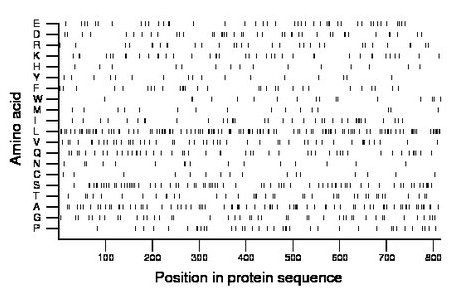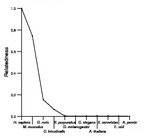
| Name: OTOA | Sequence: fasta or formatted (815aa) | NCBI GI: 24638452 | |
|
Description: otoancorin isoform 2
|
Referenced in: Auditory and Vestibular Functions
| ||
Other entries for this name:
alt prot [1060aa] otoancorin isoform 3 alt prot [1139aa] otoancorin isoform 1 | |||
|
Composition:

Amino acid Percentage Count Longest homopolymer A alanine 9.6 78 3 C cysteine 2.0 16 1 D aspartate 5.0 41 2 E glutamate 5.4 44 2 F phenylalanine 3.8 31 2 G glycine 5.4 44 1 H histidine 2.0 16 2 I isoleucine 4.5 37 2 K lysine 4.8 39 2 L leucine 14.6 119 3 M methionine 2.1 17 1 N asparagine 2.0 16 2 P proline 4.5 37 2 Q glutamine 6.0 49 3 R arginine 3.9 32 3 S serine 9.3 76 3 T threonine 4.8 39 2 V valine 6.1 50 3 W tryptophan 2.1 17 1 Y tyrosine 2.1 17 1 |
Comparative genomics:
Search single species RefSeq proteins at NCBI
Search summary 
Figure data | ||
Related human proteins:Protein Relative score Description Self-match 1.000 otoancorin isoform 2 OTOA 0.997 otoancorin isoform 3 OTOA 0.997 otoancorin isoform 1 STRC 0.054 stereocilin MSLNL 0.013 mesothelin-like VWA3A 0.009 von Willebrand factor A domain containing 3A PTPRT 0.006 protein tyrosine phosphatase, receptor type, T isof... PTPRT 0.006 protein tyrosine phosphatase, receptor type, T isof... HSN2 0.005 hereditary sensory neuropathy, type II PKN1 0.004 protein kinase N1 isoform 2 PTPRK 0.004 protein tyrosine phosphatase, receptor type, K isof... PTPRK 0.004 protein tyrosine phosphatase, receptor type, K isofo... PTPRN2 0.004 protein tyrosine phosphatase, receptor type, N poly... PTPRN2 0.004 protein tyrosine phosphatase, receptor type, N poly... PTPRN2 0.004 protein tyrosine phosphatase, receptor type, N poly... CCDC88A 0.004 coiled-coil domain containing 88A isoform 2 CCDC88A 0.004 coiled-coil domain containing 88A isoform 1 PTPRM 0.004 protein tyrosine phosphatase, receptor type, M isof... PTPRM 0.004 protein tyrosine phosphatase, receptor type, M isof... PKN1 0.004 protein kinase N1 isoform 1 MUC4 0.003 mucin 4 isoform a TPD52 0.003 tumor protein D52 isoform 3 TPD52 0.003 tumor protein D52 isoform 2 TPD52 0.003 tumor protein D52 isoform 1 POLG2 0.003 DNA-directed DNA polymerase gamma 2Human BLASTP results (used to prepare the table) | |||
Gene descriptions are from NCBI RefSeq. Search results were obtained with NCBI BLAST and RefSeq entries. When identical proteins are present, the self-match may not be listed first in BLASTP output. In such cases, the table above has been reordered to place it first.
See About the Figures for the scoring system used in the figure above right. The same scoring system was used in the table of BLASTP results.
Guide to the Human Genome
Copyright © 2010 by Stewart Scherer. All rights reserved.
